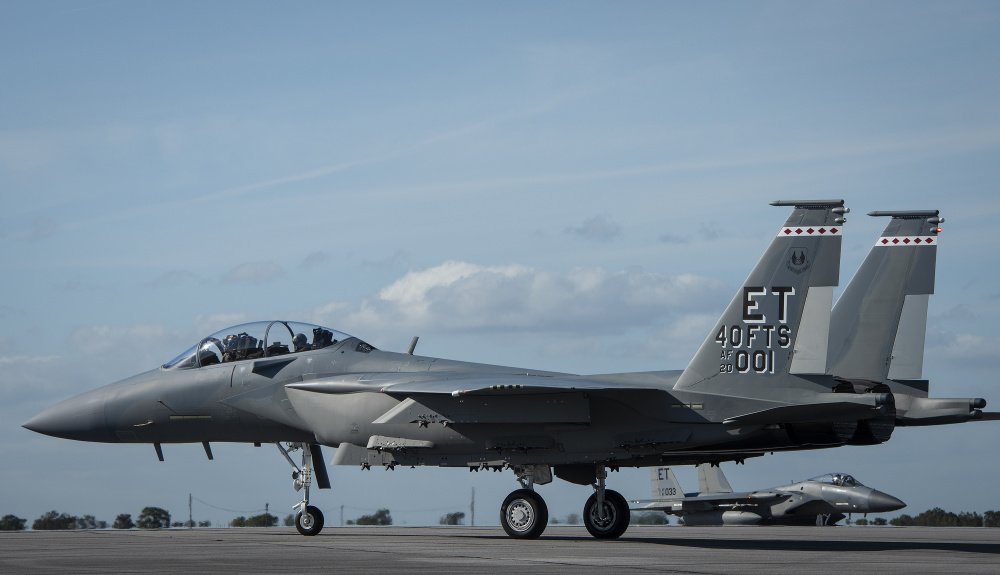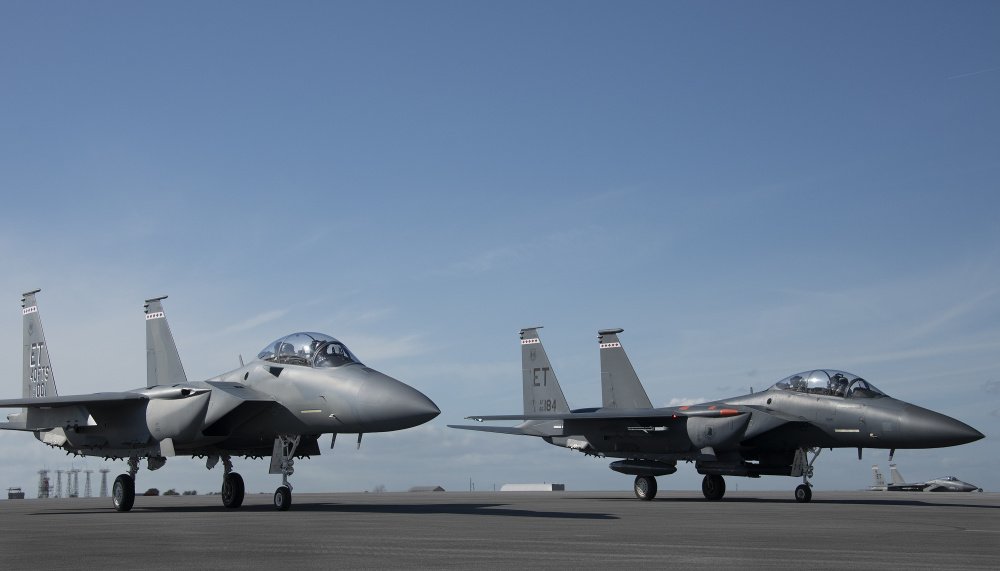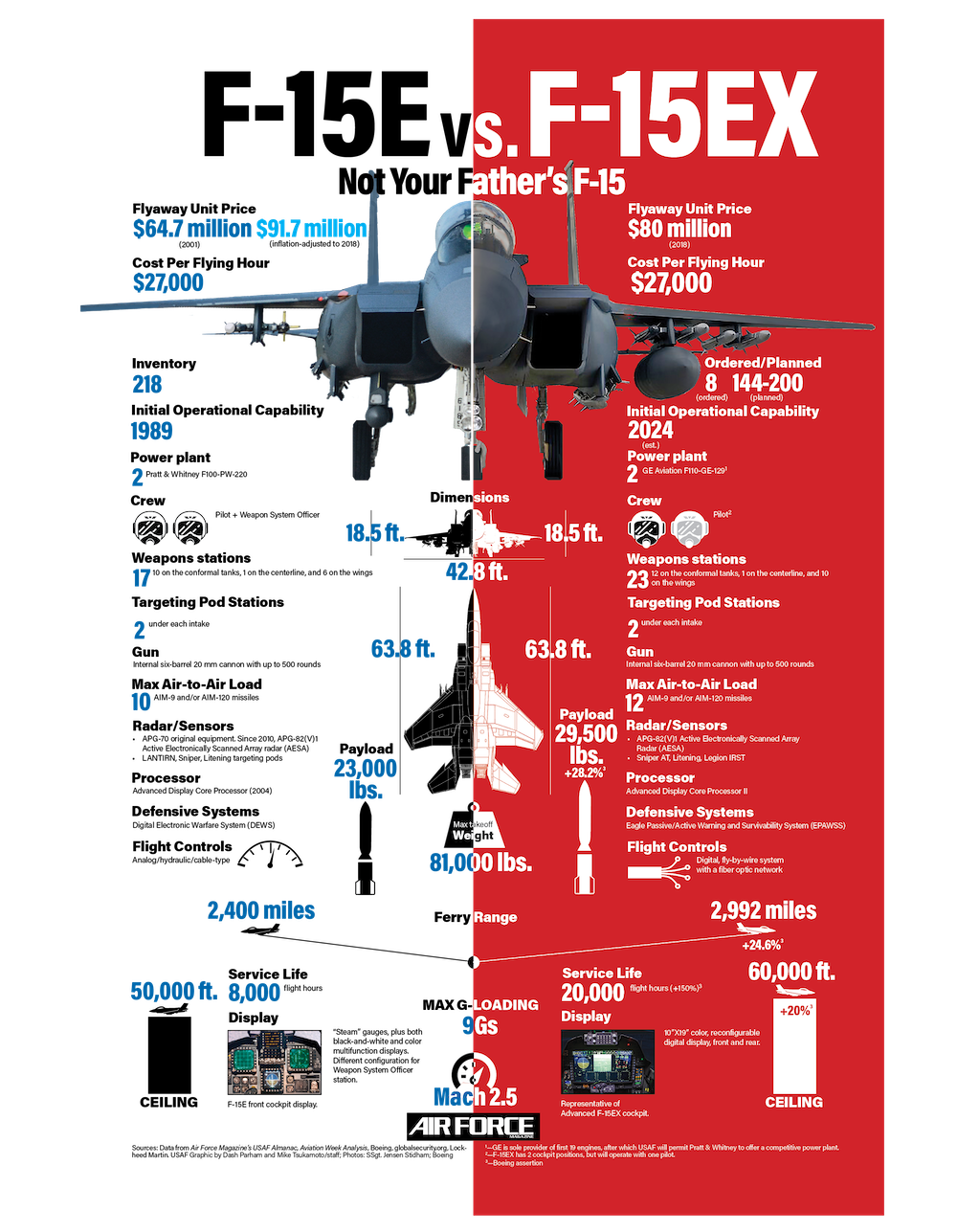
The F-15EX, the Air Force’s newest fighter aircraft, rolls by an F-15C March 11 at Eglin Air Force Base, Fla. US Air Force photo by Ilka Cole, courtesy of DVIDS.
During an April 7 ceremony at Eglin Air Force Base in Florida, the Air Force unveiled the name of its newest aircraft — the F-15EX “Eagle II.”
The Air Force accepted delivery of the first Eagle II on March 10. A second Eagle II is expected to arrive at Eglin Air Force Base within weeks. Overall, the Air Force plans to buy a total of 144 of the aircraft over the next 10 to 12 years.
Air Force Lt. Gen. Duke Z. Richardson, military deputy in the Office of the Assistant Secretary of the Air Force for Acquisition, Technology, and Logistics, said the Eagle II is slated to replace the aging F-15C/D fleet. Those older fighters have an average age of 37 years and are nearing the end of their life cycle. Richardson also mentioned that 10% of the current F-15 fleet is grounded due to structural issues, with 75% flying beyond their service life.
“Undefeated in aerial combat, the F-15 Eagle epitomized air superiority in the minds of our adversaries, allies, and the American people for over 45 years,” said Richardson. “But it was not meant to fly forever.”

Due to similarities between the Eagle II and the existing F-15 fleet, the Air Force is able to use existing infrastructure to “rapidly transition to F-15EX operations and maintenance,” Richardson said. Notably, the Eagle II acquisition process has gone ahead of schedule. The initial two Eagle IIs will be delivered within nine months of the contract award, as opposed to the normal 39 months, Richardson said.
Overall the Eagle II represents a modern upgrade to a legendary weapons system. First introduced in 1974 as an “air superiority” fighter, the F-15 has gone through a series of upgrades over the years, with all previous models primarily focused on aerial combat. The Eagle II is the first new variant of the venerable Eagle series of fighters in 17 years. In 2004 the Air Force began receiving the F-15E “Strike Eagle” and currently operates 218 of the strike fighters.
The first flight of the Air Force’s F-35A Lightning II was in 2006.
The Eagle II is designed for both air-to-air and air-to-ground missions. The aircraft is able to tackle a wide gamut of ground attack missions while retaining state-of-the art avionics and air-to-air capabilities.

“With its large weapons capacity, digital backbone, and open architecture, the F-15EX will be a key element of our tactical fighter fleet and complement fifth-generation assets for decades to come,” said Col. Sean Dorey, F-15EX program manager with the Air Force Life Cycle Management Center’s Fighters and Advanced Aircraft Directorate.
The Eagle II can carry nearly two dozen air-to-air missiles courtesy of new AMBER missile racks. When it comes to air-to-ground weapons, the Eagle II will be able to carry virtually every munition in the US inventory. This includes the Paveway series of laser-guided bombs, and JDAM satellite-guided weapons.
The plane also has the ability to carry future hypersonic weapons and features other advanced systems, including the AN/APG-82 radar, an integrated electronic warfare suite, the Eagle Passive/Active Warning and Survivability System, enhanced fly-by-wire controls, and an all-digital cockpit with flat-screen displays and touch panels.
The Eagle II has an anticipated service life of at least 35 years. This would make the Eagle series of aircraft the longest continuously serving fighter of all time — with a life span stretching to 80-plus years.
Read Next:

James Webb served as a US Marine infantryman from 2005 to 2010, completing a combat tour in Iraq. He’s worked as a freelance writer and photojournalist covering US troops in Afghanistan, and Webb spent more than two years in the US Senate as a military legislative assistant and as the personal representative of a member on the US Senate Foreign Relations Committee.
BRCC and Bad Moon Print Press team up for an exclusive, limited-edition T-shirt design!
BRCC partners with Team Room Design for an exclusive T-shirt release!
Thirty Seconds Out has partnered with BRCC for an exclusive shirt design invoking the God of Winter.
Lucas O'Hara of Grizzly Forge has teamed up with BRCC for a badass, exclusive Shirt Club T-shirt design featuring his most popular knife and tiomahawk.
Coffee or Die sits down with one of the graphic designers behind Black Rifle Coffee's signature look and vibe.
Biden will award the Medal of Honor to a Vietnam War Army helicopter pilot who risked his life to save a reconnaissance team from almost certain death.
Ever wonder how much Jack Mandaville would f*ck sh*t up if he went back in time? The American Revolution didn't even see him coming.
A nearly 200-year-old West Point time capsule that at first appeared to yield little more than dust contains hidden treasure, the US Military Academy said.












